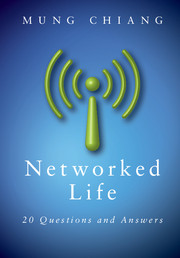Book contents
- Frontmatter
- Contents
- Preface
- Acknowledgements
- Roadmap
- 1 What makes CDMA work for my smartphone?
- 2 How does Google sell ad spaces?
- 3 How does Google rank webpages?
- 4 How does Netflix recommend movies?
- 5 When can I trust an average rating on Amazon?
- 6 Why does Wikipedia even work?
- 7 How do I viralize a YouTube video and tip a Groupon deal?
- 8 How do I influence people on Facebook and Twitter?
- 9 Can I really reach anyone in six steps?
- 10 Does the Internet have an Achilles' heel?
- 11 Why do AT&T and Verizon Wireless charge me $10 a GB?
- 12 How can I pay less for each GB?
- 13 How does traffic get through the Internet?
- 14 Why doesn't the Internet collapse under congestion?
- 15 How can Skype and Bit Torrent be free?
- 16 What's inside the cloud of iCloud?
- 17 IPTV and Netflix: How can the Internet support video?
- 18 Why is WiFi faster at home than at a hotspot?
- 19 Why am I getting only a few % of the advertised 4G speed?
- 20 Is it fair that my neighbor's iPad downloads faster?
- Index
- Notes
17 - IPTV and Netflix: How can the Internet support video?
Published online by Cambridge University Press: 05 November 2012
- Frontmatter
- Contents
- Preface
- Acknowledgements
- Roadmap
- 1 What makes CDMA work for my smartphone?
- 2 How does Google sell ad spaces?
- 3 How does Google rank webpages?
- 4 How does Netflix recommend movies?
- 5 When can I trust an average rating on Amazon?
- 6 Why does Wikipedia even work?
- 7 How do I viralize a YouTube video and tip a Groupon deal?
- 8 How do I influence people on Facebook and Twitter?
- 9 Can I really reach anyone in six steps?
- 10 Does the Internet have an Achilles' heel?
- 11 Why do AT&T and Verizon Wireless charge me $10 a GB?
- 12 How can I pay less for each GB?
- 13 How does traffic get through the Internet?
- 14 Why doesn't the Internet collapse under congestion?
- 15 How can Skype and Bit Torrent be free?
- 16 What's inside the cloud of iCloud?
- 17 IPTV and Netflix: How can the Internet support video?
- 18 Why is WiFi faster at home than at a hotspot?
- 19 Why am I getting only a few % of the advertised 4G speed?
- 20 Is it fair that my neighbor's iPad downloads faster?
- Index
- Notes
Summary
We saw in Chapter 13 that the Internet provides a “best effort,” i.e., “no effort” service. So, how can it support video distribution that often imposes stringent demands on throughput and delay?
A Short Answer
Viewing models
Watching video is a significant part of many people's daily life, and it is increasingly dependent on the Internet and wireless networks. Movies, TV shows, and home videos flow from the cloud through the IP network to mobile devices. This trend is changing both the networking and the entertainment industries. As of 2011, there were more than 100 million IPTV users in the USA, and Youtube and Netflix together take up about half of the Internet capacity usage. As the trend of decoupling among contents, content delivery channels, and content-consuming devices intensifies, IP has become the basis of almost all the content distribution systems.
This trend is bringing about a revolution in our viewing habits.
• Content type: Both user-generated and licensed content have become prevalent. Clearly, more user-generated content implies an increasing need for upload capacity, which is traditionally designed to be much smaller than download capacity.
• When: For many types of video content, we can watch them anytime we want, with the help of devices like a Digital Video Recorder (DVR) on IPTV or services like HBO Go.
• Where: We can watch video content almost anywhere, at least anywhere with a sufficiently fast Internet connection.
[…]
- Type
- Chapter
- Information
- Networked Life20 Questions and Answers, pp. 380 - 405Publisher: Cambridge University PressPrint publication year: 2012



